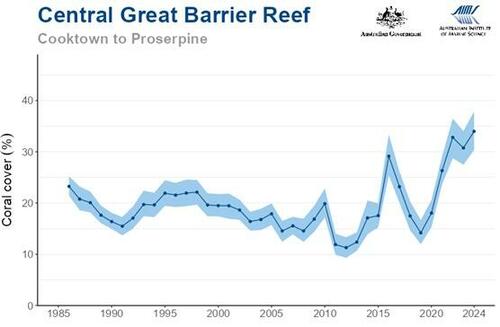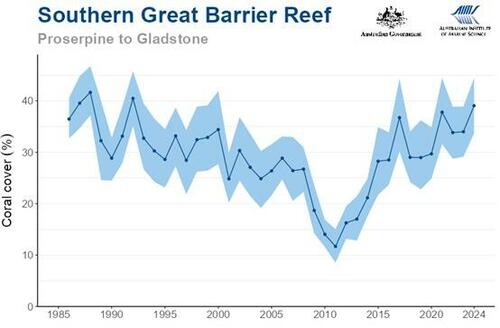
Authored by Chris Morrison via DailySceptic.org,
Massive increases in coral across the Australian Great Barrier Reef (GBR) have been reported for 2023-24 making it the third record year in a row of heavy growth. Across almost all parts of the 1,500 mile long reef, from the warmer northern waters to the cooler conditions in the south, coral is now at its highest level since detailed observations began. The inconvenient news has been ignored in mainstream media which, curiously, have focused on a non-story in Nature that claimed “climate change” poses an “existential threat” to the GBR.
“The science tells us that the GBR is in danger – and we should be guided by the science,” Professor Helen McGregor from the University of Wollongong told Victoria Gill of BBC News.
The existential threat is “now realised” reported the Guardian.
Travelling back from the reality inhabited by the Guardian, it can be reported that last year’s gains were eye-catchingly large. On the Northern GBR, hard coral cover leapt from 35.8% to 39.5%, in the central area it rose from 30.7% to 34%, while in the south it went from 34% to 39.1%. The report is the result of monitoring of hard coral cover reefs from August 2023 to June 2024 by the Australian Institute of Marine Science (AIMS). The percentage of hard coral cover is a standard measurement of reef conditions used by scientists and is said to provide a simple and robust measure of reef health. Similar reports have been published by the AIMS over the last 38 years.
For the first two years of record coral growth, the narrative-driven mainstream media ignored the recovery story. But this year, the suspicious might contend, something had to be done to blunt the sensational news of the stonking rises. Help has come in the form of a paper just published in Nature which uses proxy temperature measurements and climate models to suggest temperatures around the vast reef area are the highest recorded in 400 years. This time period is the blink of an ecological eye-lid given that coral has been around for hundreds of millions of years during periods when temperatures and atmospheric carbon dioxide have been markedly different. Nevertheless, this is said to pose an existential threat despite it being known that sub-tropical corals thrive between 24°C-32°C, and in fact seem to grow faster in warmer waters.
Natural bleaching, when the coral expels algae and turns white, can occur with temporary local temperature changes, but evidence from many years of scientific observation suggests the corals often and quickly recover. Long term changes in water temperature – tiny compared to coral’s optimum conditions – pose no threat, but alarmists concentrate on the bleaching events to warn of possible ecological collapse. The Guardian noted a recent fifth mass bleaching in eight years across the reef, driven, it claimed, by “global heating”. So far, its readers are in the dark as to how this squares with the recent record growth.
A decade of mass bleaching, relentlessly catastrophised in the interests of Net Zero by activists in the media, academia and politics, does not appear to have done much harm to the recent growth in the Northern GBR.
Or the central area.
Or even in the south where the water temperatures are slightly cooler.
To read the latest AIMS report is to read the best possible spin on the story that the reef is heading for disaster. And, of course, it is all down to the unproven changes in climate that are said to be caused by human activity. It is claimed this will cause more frequent and long-lasting marine ‘heatwaves’, a product no doubt of a climate model. It is generally suggested that these heatwaves and mass bleaching were rare prior to the 1990s, although how anyone can know this is a mystery. Detailed GBR observations and temperature recordings barely stretch back a few decades.
As is often the case with publicly-funded operations, the political message is never far from the surface. Thus we learn that “enabling coral reefs to survive these stressful conditions requires a combination of a reduction in global greenhouse emissions to stabilise temperatures… and the development of interventions to help reefs adapt to and recover from the effects of climate change”. No doubt this last proposal requires large amounts of money from the taxpayer to cover the costs of such worthy work.
Not everyone goes along with the coral fear-mongering. The distinguished scientist Dr. Peter Ridd has studied the GBR for 40 years and notes that coral numbers have “exploded” in recent years. He says that all 3,000 reefs in the world’s largest system have excellent coral. “Not a single reef or even a single species of reef life has been lost since British settlement,” he reports. The impact of bleaching is “routinely exaggerated by the media and some scientific organisations”. In his view, the public is being deceived about the reef. “How this occurred is a serious issue for the reef-science community which has embraced emotion, ideology and raw self-interest to maintain funding,” he observes.
Authored by Chris Morrison via DailySceptic.org,
Massive increases in coral across the Australian Great Barrier Reef (GBR) have been reported for 2023-24 making it the third record year in a row of heavy growth. Across almost all parts of the 1,500 mile long reef, from the warmer northern waters to the cooler conditions in the south, coral is now at its highest level since detailed observations began. The inconvenient news has been ignored in mainstream media which, curiously, have focused on a non-story in Nature that claimed “climate change” poses an “existential threat” to the GBR.
“The science tells us that the GBR is in danger – and we should be guided by the science,” Professor Helen McGregor from the University of Wollongong told Victoria Gill of BBC News.
The existential threat is “now realised” reported the Guardian.
Travelling back from the reality inhabited by the Guardian, it can be reported that last year’s gains were eye-catchingly large. On the Northern GBR, hard coral cover leapt from 35.8% to 39.5%, in the central area it rose from 30.7% to 34%, while in the south it went from 34% to 39.1%. The report is the result of monitoring of hard coral cover reefs from August 2023 to June 2024 by the Australian Institute of Marine Science (AIMS). The percentage of hard coral cover is a standard measurement of reef conditions used by scientists and is said to provide a simple and robust measure of reef health. Similar reports have been published by the AIMS over the last 38 years.
For the first two years of record coral growth, the narrative-driven mainstream media ignored the recovery story. But this year, the suspicious might contend, something had to be done to blunt the sensational news of the stonking rises. Help has come in the form of a paper just published in Nature which uses proxy temperature measurements and climate models to suggest temperatures around the vast reef area are the highest recorded in 400 years. This time period is the blink of an ecological eye-lid given that coral has been around for hundreds of millions of years during periods when temperatures and atmospheric carbon dioxide have been markedly different. Nevertheless, this is said to pose an existential threat despite it being known that sub-tropical corals thrive between 24°C-32°C, and in fact seem to grow faster in warmer waters.
Natural bleaching, when the coral expels algae and turns white, can occur with temporary local temperature changes, but evidence from many years of scientific observation suggests the corals often and quickly recover. Long term changes in water temperature – tiny compared to coral’s optimum conditions – pose no threat, but alarmists concentrate on the bleaching events to warn of possible ecological collapse. The Guardian noted a recent fifth mass bleaching in eight years across the reef, driven, it claimed, by “global heating”. So far, its readers are in the dark as to how this squares with the recent record growth.
A decade of mass bleaching, relentlessly catastrophised in the interests of Net Zero by activists in the media, academia and politics, does not appear to have done much harm to the recent growth in the Northern GBR.
Or the central area.
Or even in the south where the water temperatures are slightly cooler.
To read the latest AIMS report is to read the best possible spin on the story that the reef is heading for disaster. And, of course, it is all down to the unproven changes in climate that are said to be caused by human activity. It is claimed this will cause more frequent and long-lasting marine ‘heatwaves’, a product no doubt of a climate model. It is generally suggested that these heatwaves and mass bleaching were rare prior to the 1990s, although how anyone can know this is a mystery. Detailed GBR observations and temperature recordings barely stretch back a few decades.
As is often the case with publicly-funded operations, the political message is never far from the surface. Thus we learn that “enabling coral reefs to survive these stressful conditions requires a combination of a reduction in global greenhouse emissions to stabilise temperatures… and the development of interventions to help reefs adapt to and recover from the effects of climate change”. No doubt this last proposal requires large amounts of money from the taxpayer to cover the costs of such worthy work.
Not everyone goes along with the coral fear-mongering. The distinguished scientist Dr. Peter Ridd has studied the GBR for 40 years and notes that coral numbers have “exploded” in recent years. He says that all 3,000 reefs in the world’s largest system have excellent coral. “Not a single reef or even a single species of reef life has been lost since British settlement,” he reports. The impact of bleaching is “routinely exaggerated by the media and some scientific organisations”. In his view, the public is being deceived about the reef. “How this occurred is a serious issue for the reef-science community which has embraced emotion, ideology and raw self-interest to maintain funding,” he observes.
Loading…








